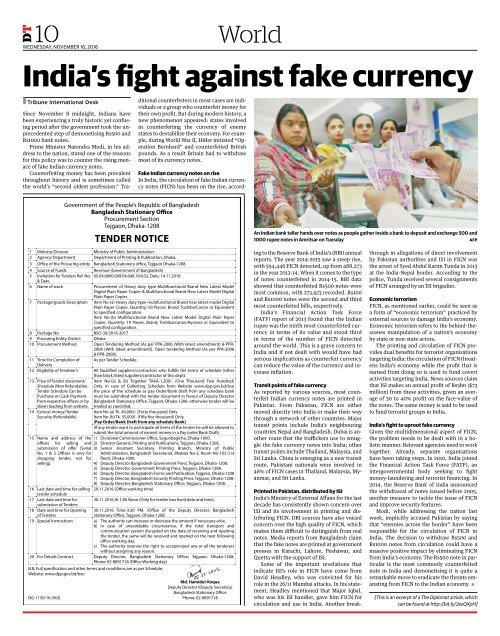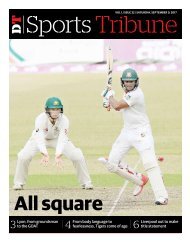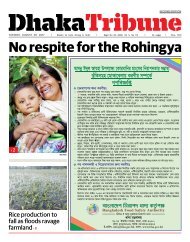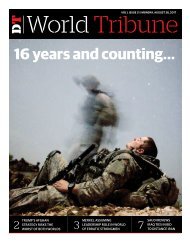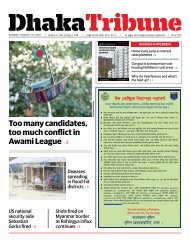ePaper_2nd Edition_November 16, 2016
Create successful ePaper yourself
Turn your PDF publications into a flip-book with our unique Google optimized e-Paper software.
10<br />
WEDNESDAY, NOVEMBER <strong>16</strong>, 20<strong>16</strong><br />
DT<br />
World<br />
India’s fight against fake currency<br />
• Tribune International Desk<br />
Since <strong>November</strong> 8 midnight, Indians have<br />
been experiencing a truly historic yet confusing<br />
period after the government took the unprecedented<br />
step of demonetising Rs500 and<br />
Rs1000 bank notes.<br />
Prime Minister Narendra Modi, in his address<br />
to the nation, stated one of the reasons<br />
for this policy was to counter the rising menace<br />
of fake Indian currency notes.<br />
Counterfeiting money has been prevalent<br />
throughout history and is sometimes called<br />
the world’s “second oldest profession.” Traditional<br />
counterfeiters in most cases are individuals<br />
or a group who counterfeit money for<br />
their own profit. But during modern history, a<br />
new phenomenon appeared: states involved<br />
in counterfeiting the currency of enemy<br />
states to destabilise their economy. For example,<br />
during World War II, Hitler initiated “Operation<br />
Bernhard” and counterfeited British<br />
pounds. As a result Britain had to withdraw<br />
most of its currency notes.<br />
An Indian bank teller hands over notes as people gather inside a bank to deposit and exchange 500 and<br />
1000 rupee notes in Amritsar on Tuesday AFP<br />
Fake Indian currency notes on rise<br />
In India, the circulation of fake Indian currency<br />
notes (FICN) has been on the rise, according<br />
to the Reserve Bank of India’s (RBI) annual<br />
reports. The year 2014-2015 saw a steep rise,<br />
with 594,446 FICN detected, up from 488,273<br />
in the year 2013-14. When it comes to the type<br />
of notes counterfeited in 2014-15, RBI data<br />
showed that counterfeited Rs500 notes were<br />
most common, with 273,923 recorded. Rs100<br />
and Rs1000 notes were the second and third<br />
most counterfeited bills, respectively.<br />
India’s Financial Action Task Force<br />
(FATF) report of 2013 found that the Indian<br />
rupee was the ninth most counterfeited currency<br />
in terms of its value and stood third<br />
in terms of the number of FICN detected<br />
around the world. This is a grave concern to<br />
India and if not dealt with would have had<br />
serious implications as counterfeit currency<br />
can reduce the value of the currency and increase<br />
inflation.<br />
Transit points of fake currency<br />
As reported by various sources, most counterfeit<br />
Indian currency notes are printed in<br />
Pakistan. From Pakistan, FICN are either<br />
moved directly into India or make their way<br />
through a network of other countries. Major<br />
transit points include India’s neighbouring<br />
countries Nepal and Bangladesh. Dubai is another<br />
route that the traffickers use to smuggle<br />
the fake currency notes into India; other<br />
transit points include Thailand, Malaysia, and<br />
Sri Lanka. China is emerging as a new transit<br />
route. Pakistani nationals were involved in<br />
48% of FICN cases in Thailand, Malaysia, Myanmar,<br />
and Sri Lanka.<br />
Printed in Pakistan, distributed by ISI<br />
India’s Ministry of External Affairs for the last<br />
decade has consistently shown concern over<br />
ISI and its involvement in printing and distributing<br />
FICN. DRI sources have also voiced<br />
concern over the high quality of FICN, which<br />
makes them difficult to distinguish from real<br />
notes. Media reports from Bangladesh claim<br />
that the fake notes are printed at government<br />
presses in Karachi, Lahore, Peshawar, and<br />
Quetta with the support of ISI.<br />
Some of the important revelations that<br />
indicate ISI’s role in FICN have come from<br />
David Headley, who was convicted for his<br />
role in the 26/11 Mumbai attacks. In his statement,<br />
Headley mentioned that Major Iqbal,<br />
who was his ISI handler, gave him FICN for<br />
circulation and use in India. Another breakthrough<br />
in allegations of direct involvement<br />
by Pakistan authorities and ISI in FICN was<br />
the arrest of Syed Abdul Karim Tunda in 2013<br />
at the India-Nepal border. According to the<br />
police, Tunda received several consignments<br />
of FICN arranged by an ISI brigadier.<br />
Economic terrorism<br />
FICN, as mentioned earlier, could be seen as<br />
a form of “economic terrorism” practiced by<br />
external sources to damage India’s economy.<br />
Economic terrorism refers to the behind-thescenes<br />
manipulation of a nation’s economy<br />
by state or non-state actors.<br />
The printing and circulation of FICN provides<br />
dual benefits for terrorist organisations<br />
targeting India: the circulation of FICN threatens<br />
India’s economy while the profit that is<br />
earned from doing so is used to fund covert<br />
activities targeting India. News sources claim<br />
that ISI makes an annual profit of Rs5bn ($73<br />
million) from these activities, given an average<br />
of 30 to 40% profit on the face-value of<br />
the notes. The same money is said to be used<br />
to fund terrorist groups in India.<br />
India’s fight to uproot fake currency<br />
Given the multidimensional aspect of FICN,<br />
the problem needs to be dealt with in a holistic<br />
manner. Relevant agencies need to work<br />
together. Already, separate organisations<br />
have been taking steps. In 2010, India joined<br />
the Financial Action Task Force (FATF), an<br />
intergovernmental body seeking to fight<br />
money-laundering and terrorist financing. In<br />
2014, the Reserve Bank of India announced<br />
the withdrawal of notes issued before 2005,<br />
another measure to tackle the issue of FICN<br />
and improve security features.<br />
Modi, while addressing the nation last<br />
week, implicitly accused Pakistan by saying<br />
that “enemies across the border” have been<br />
responsible for the circulation of FICN in<br />
India. The decision to withdraw Rs500 and<br />
Rs1000 notes from circulation could have a<br />
massive positive impact by eliminating FICN<br />
from India’s economy. The Rs500 note in particular<br />
is the most commonly counterfeited<br />
note in India and demonetising it is quite a<br />
remarkable move to eradicate the threats emanating<br />
from FICN to the Indian economy. •<br />
[This is an excerpt of a The Diplomat article, which<br />
can be found at http://bit.ly/2ezQXpH]


